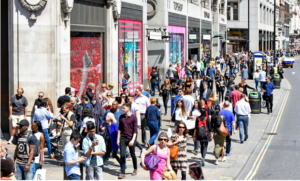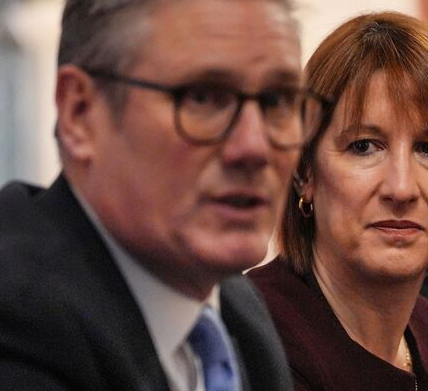Mayor to be given power to overrule Westminster council, which blocked previous plan amid concerns over rerouting buses

Sadiq Khan maintains that a pedestrianised Oxford Street would enjoy increased footfall and spending, and generate increased tax revenue. Photograph: Justin Kase zsixz/Alamy
Traffic will be banned from London’s Oxford Street under plans announced by the mayor, Sadiq Khan, using new powers from Labour to push through long-thwarted pedestrianisation of the capital’s famous shopping strip.
Khan said urgent action was needed so that the mile-long street could “once again become the leading retail destination in the world.”
The deputy prime minister, Angela Rayner, is expected to sign off a proposed mayoral development area, giving greater powers to Khan as he revives the plans he first laid out in 2017.
The news was met with dismay by Westminster council, which blocked the previous plan amid businesses’ and residents’ concerns over rerouting buses, and whose own £90m “shovel-ready” regeneration plans for the street may now be superseded.

Politicians and retailers have for years sought to breathe new life into a street whose renown and cultural position on the most expensive side of the Monopoly board has long been at odds with a down-at-heel reality, even before the proliferation of shops selling American candy and dubious souvenirs.
A 1960s plan to carry shoppers via a travelator and a 1970s scheme for a track carrying cars on air cushions failed to take off. Traffic has been incrementally limited since proposals for pedestrianisation under the former London mayor Ken Livingstone were knocked back two decades ago.
Now, under the new plans and almost a century after horse and carts were banned in an attempt to end slow-moving traffic, the red double-decker buses and black cabs that queue down Oxford Street would be rerouted elsewhere.

Khan maintains that a pedestrianised street would enjoy increased footfall and spending, and generate increased tax revenue. He said: “Oxford Street was once the jewel in the crown of Britain’s retail sector but there’s no doubt that it has suffered hugely over the last decade. Urgent action is needed to give the nation’s most famous high street a new lease of life.
“I am excited to be working with the new government, and local retailers and businesses, on these plans that will help to restore this famous part of the capital to its former glory.”
As secretary of state for housing, communities and local government, Rayner can allow Khan to establish a mayoral development corporation with planning powers. Rayner said: “Oxford Street is a world-renowned shopping destination and we want it to stay that way.”

Oxford Street has recently begun to bounce back from a plunge in visitor numbers during the pandemic when restrictions on retailing and international and local travel hit hard, and about 500,000 people now visit daily. Vacancies soared as big department stores including Debenhams and House of Fraser closed down, while space was filled by a flurry of candy shops that were seen to lower the appeal of the street.
Westminster council’s own vision, a slimmed-down £90m redevelopment plan for the street in partnership with the New West End Company trade body, was given the green light earlier this year – including new seating, lighting and 64 new or improved pedestrian crossings.
Contractors have started some works, and the council appears to have been blindsided by Khan’s plan. It believes direct bus access is crucial for many shoppers and workers – particularlydisabled people, elderly people, families and those on low incomes.
Stuart Love, the Westminster council chief executive, said it had spent two years working with businesses and residents on its detailed proposals. “These plans are shovel-ready, have had the support of retailers and the local community and were intended to deliver significant economic growth … The latest pedestrianisation proposal from the mayor of London was only shared with us last Thursday.”

Steve McNamara, of the Licensed Taxi Drivers’ Association, said the ranks outside John Lewis and Selfridges were two of the busiest in London. He said many redesigns of bus and taxi routes were ignoring the accessibility needs of vulnerable Londoners who relied on such transport.
The western, wider side of Oxford Street, home to the more upmarket department stores of Selfridges and John Lewis, will be the first stretch to be pedestrianised.
Retailers on the street gave the plans a cautious welcome. The John Lewis executive director, Peter Ruis, said it remained “extremely proud” to be on what he called “the nation’s high street”, where the chain opened its first store in 1864. He added: “We’re delighted to see the plans announced today.”
Dee Corsi, the chief executive of New West End Company, representing businesses trading on Oxford Street, said it was encouraged, having “long championed the transformation of Oxford Street, navigating various challenges and proposals over the years”. Corsi added: “Given the history of past schemes, it is essential that we move swiftly to deliver this project.”
No date was promised by the mayor for the plans, which are subject to a statutory consultation and approval by the Labour-led London assembly. Based on the timelines of Khan’s previous proposal, the western half of Oxford Street would probably be pedestrianised by 2027.



